Key findings
- Among respondents, only 2% of farmers market shoppers considered the pricing expensive. while 95% found it affordable. This indicates widespread satisfaction with farmer’s market prices.
- Only four of the top 10 agricultural states also rank among the top 10 states with the most farmers markets.
- 91% of farmers market sellers are considered friendly by shoppers.
- An impressive 93.5% of respondents cited the freshness of produce at farmers markets as a key benefit.
Reasons for the popularity of farmers’ markets in the United States
To gain deeper insights into consumer behavior and preferences at farmers markets, we conducted a comprehensive survey. We gathered responses from individuals to understand their motivations, experiences, and perceptions. This report intends to present our key findings, highlighting the factors that draw people to these markets and what they value most in their shopping experience.
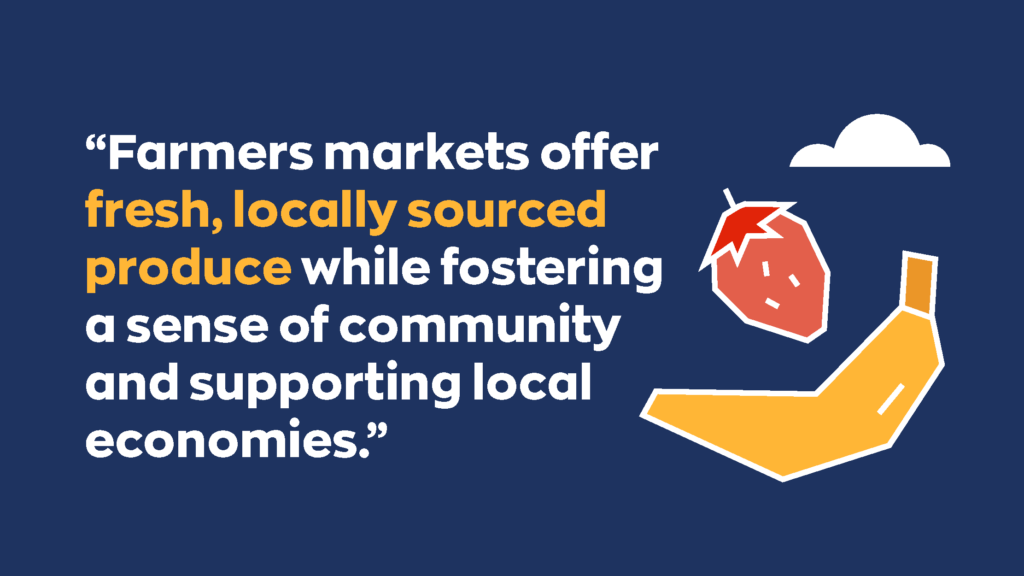
The popularity of farmers markets in the United States can be attributed to several interrelated factors that resonate with consumers’ evolving preferences and values. Data and statistics from other surveys help illustrate some of these reasons by providing concrete evidence of consumer preferences and experiences. For example, between April and October 2017, researchers for the science journal Food Control sent surveys to farmers’ market customers at eight different marketplaces from 239 completed questionnaires. The findings found that 97% of respondents rated product freshness and flavor as “very significant” or “very essential” reasons for shopping at local farmers markets.
Lively interactions with neighbors and farmers can create a sense of local connection. When asked about the benefits of visiting a farmers market, our survey found that social atmosphere and community engagement are top selling points, making the market a vibrant social hub. Similarly, respondents to a USDA survey frequently highlighted freshness, community engagement, and supporting local businesses as key motivators.
Further, the continuous availability of fresh produce and other goods highlights how well vendors keep track of their inventory. By staying on top of their inventory, especially with the help of an inventory management system, they can ensure popular items are always in stock, and the selection stays varied for their customers. The reasonable pricing of high-quality goods and the friendly interactions with vendors further enhance the appeal.
Additionally, the desire for transparency and trust in food sources, coupled with environmental concerns, underscores why farmers markets have become favored destinations for many Americans. In our survey, over 51% of respondents said they trust the quality of ingredients at farmers markets more than they do supermarket food.
Farmers markets address the multifaceted needs and values of today’s consumers, making them an integral part of the local food landscape. In addition, these insights offer a clear understanding of why farmers markets are so popular and the specific benefits that attract shoppers. Below are the benefits of visiting a farmers market.
Supporting local farms
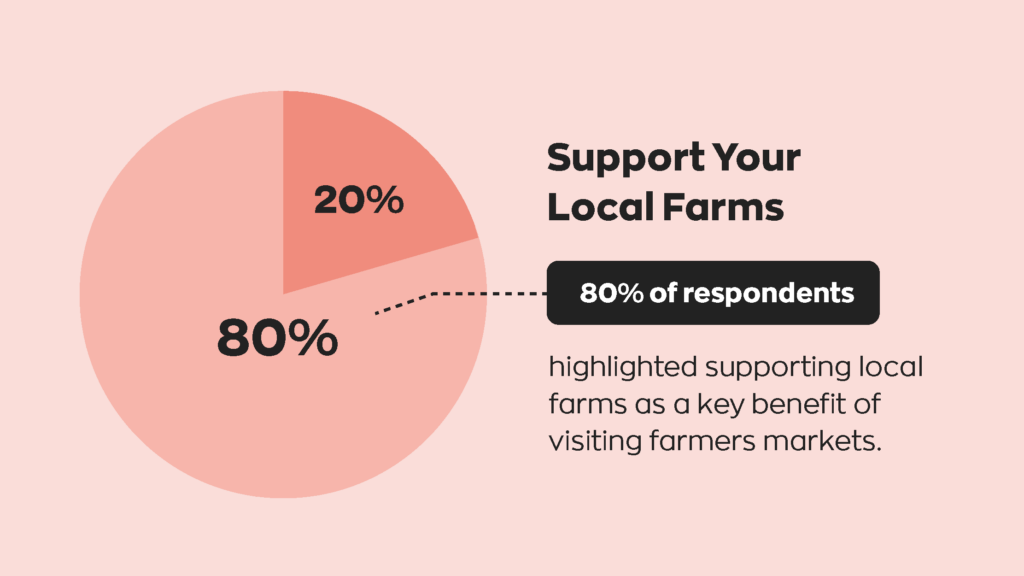
In our survey, 80% of respondents highlighted supporting local farms as a key benefit of visiting farmers markets. This support stands out as a significant motivator for many market-goers. Farmers markets play a crucial role in supporting local economies by providing a direct sales outlet for small-scale farmers and artisans. Vendors do their part by regularly updating their inventory based on customer preferences and what sells well. This careful attention to stock helps them meet customers’ needs effectively — so they’re interested in returning to their favorite vendors — and contributes to the lively and sustainable atmosphere of the market.
Over 48% of survey respondents said farmers markets positively impact the local economy by supporting local agriculture and small-scale farmers. Another 15% said they boost local businesses by increasing foot traffic, 10% said they create jobs in the community, and 20% said they encourage local spending.
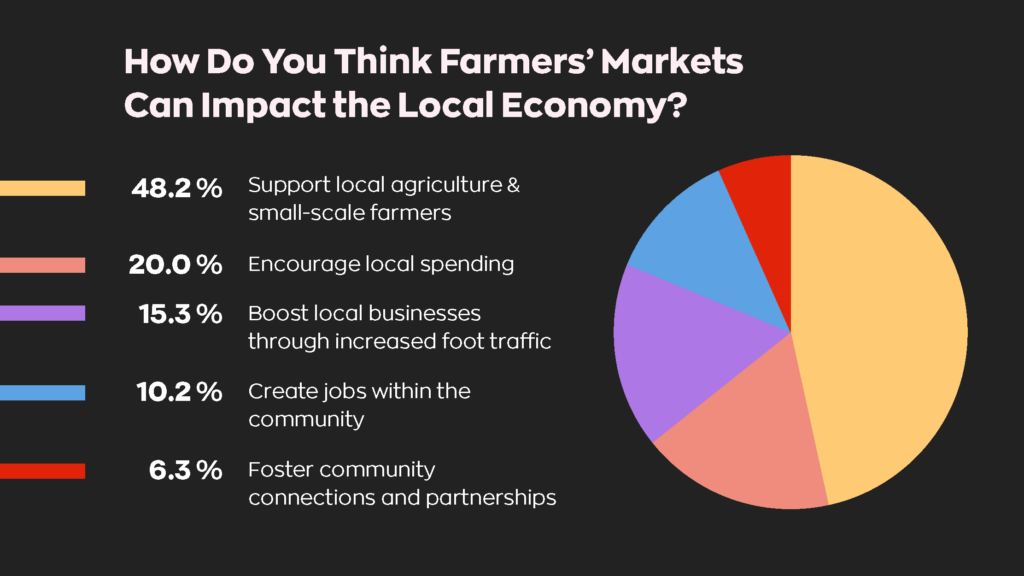
By cutting out the middleman, farmers can retain a higher percentage of their earnings. This, in turn, boosts the local economy. This direct-to-consumer model also allows farmers to interact with their customers, receive immediate feedback, and build a loyal customer base.
In a survey from the Community-University Institute for Social Research, 90% of respondents identified the value of supporting small businesses as a key benefit of visiting these markets. The significance of supporting local businesses at farmers markets is underscored by the fact that approximately 90% of farms in the U.S. are classified as small businesses. These farms, often family-owned or operated by individuals, play a crucial role in agricultural diversity and local food systems.
Organic or health-conscious options
Farmers markets are increasingly popular among health-conscious consumers seeking these organic and dietary-friendly choices. Among 1,000 respondents to our survey, 48.5% said they measure, track, or pay attention to the nutritional content of their food. This demonstrates a significant consumer interest in dietary awareness. Additionally, 45.2% are conscious of organic or health-conscious options, while 48.7% of the people surveyed make an active effort to buy organic foods. This reflects a growing preference for organic options.
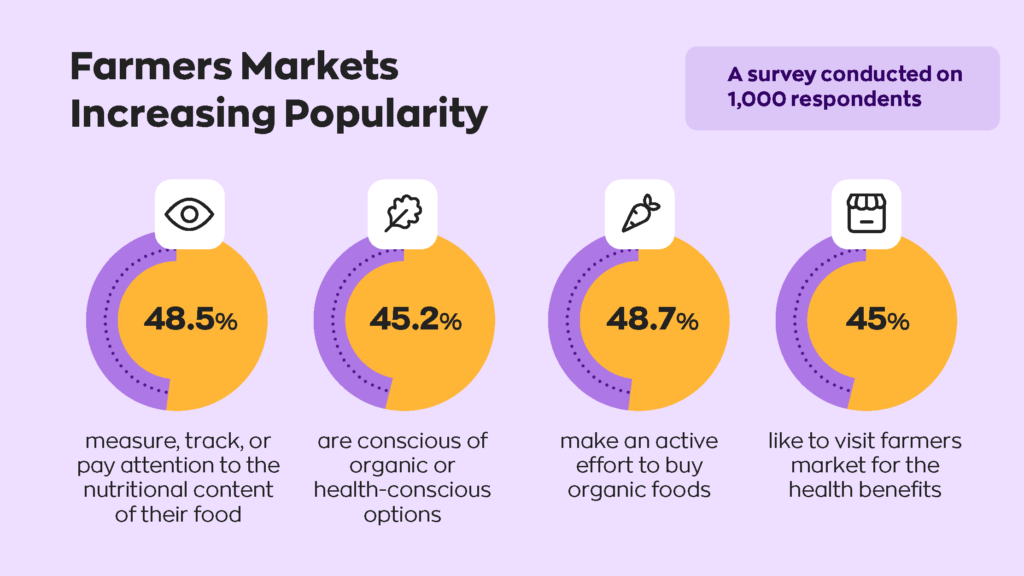
Moreover, many people like to visit farmers markets for the health benefits. For instance, 45% said organic, health-conscious options are a benefit of shopping at these markets. This benefit ranked third behind the freshness of produce and support for local farmers.
Survey respondents consistently highlight the availability of health-conscious foods as a significant benefit of visiting these markets. For instance, among 245 respondents with dietary restrictions, a mere 4% had never visited a farmers market. This indicates the market’s appeal in catering to specialized dietary needs. These markets offer a diverse selection of organic produce, gluten-free products, and other specialty items not always readily available in conventional stores.
This variety not only supports healthier eating habits but also empowers consumers to make informed choices about their diet. This helps them align with their personal health goals and preferences. The prevalence of adults living with dietary restrictions underscores the growing significance of health-conscious options offered at farmers markets. According to data from the National Health and Nutrition Examination Survey, approximately 17.1% of adults aged 20 and over reported being on some form of special diet. This includes diets tailored to specific health needs, such as gluten-free, dairy-free, or organic preferences.
Among age groups, younger adults aged 20 to 39 had a lower prevalence of special diets (13.3%) compared to those aged 40-59 (19.2%) and 60 and over (19.3%). Farmers markets not only support local economies but also serve as essential resources for consumers seeking nutritious and tailored food choices.
Freshness of produce
One of the primary reasons for the increasing popularity of farmers markets is the unparalleled freshness and quality of the produce available. Survey data shows that 93.5% of respondents cited the freshness of produce as a significant benefit of visiting farmers markets.
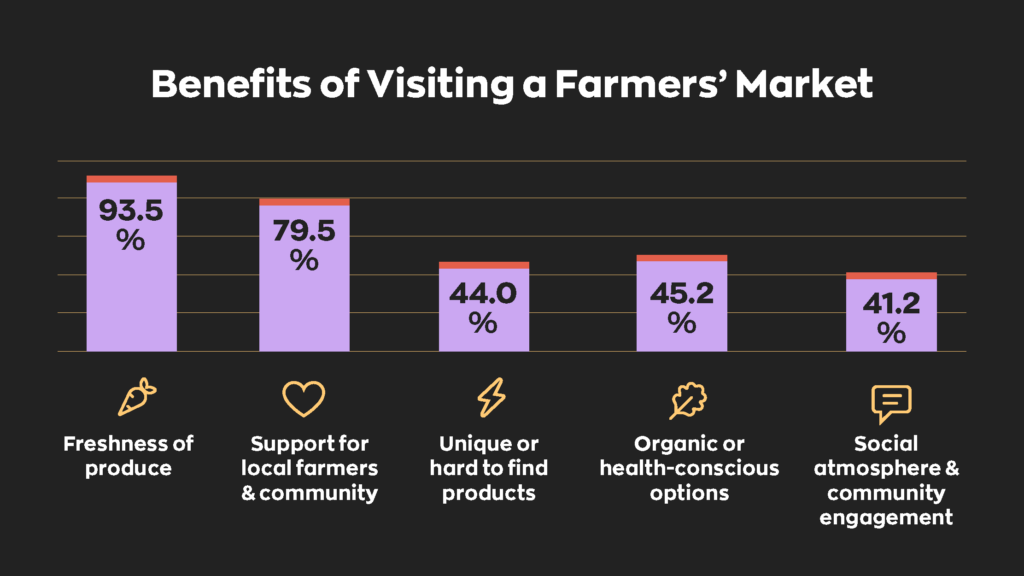
Unlike supermarket produce, which often travels long distances and is stored for extended periods, products at farmers markets are typically harvested within 24 hours of being sold, ensuring optimal freshness, flavor, and nutritional value. This freshness appeals to health-conscious consumers who prioritize the quality and taste of their food.
Environmental factors
Farmers markets are increasingly favored for their environmental sustainability practices, as perceived by visitors surveyed. A significant 88.1% of respondents felt that sustainable food production was important. This perception serves as a draw for environmentally conscious consumers who prioritize reducing their carbon footprint and supporting eco-friendly agricultural practices. Additionally, 66% of respondents also said the origin and distance food has to travel to get to the market are important considerations for their purchasing decisions.
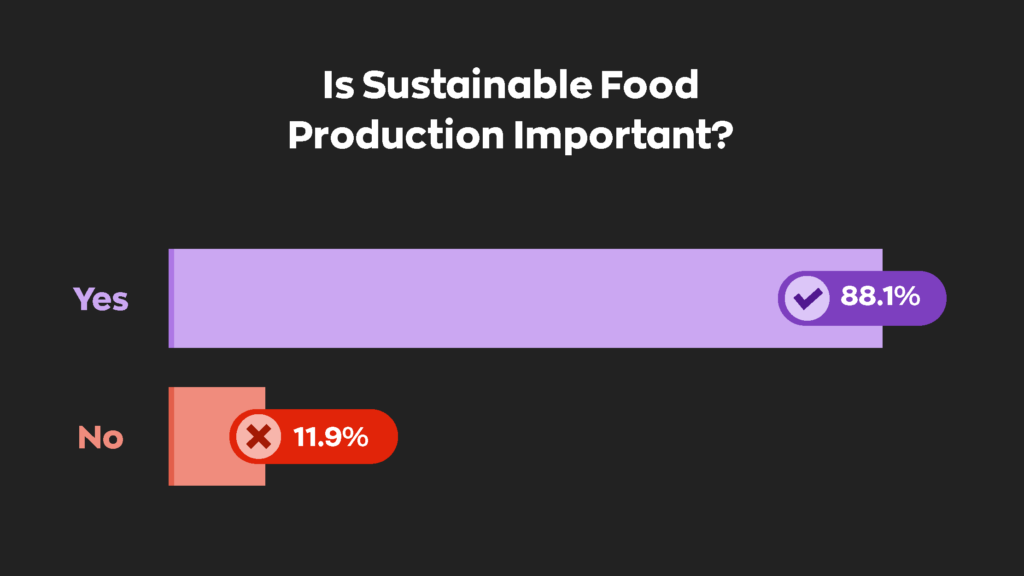
Survey results indicate that many visitors to farmers markets value the direct interaction with sellers. This allows them to inquire about farming techniques and sustainability efforts firsthand. This transparency fosters trust and confidence in the environmental stewardship of farmers, reinforcing the market’s appeal as a sustainable shopping option.
Price
Price plays a crucial role in the popularity of farmers markets, as highlighted by survey results indicating consumer perceptions of affordability. A significant 67% of respondents found prices at farmers markets to be at least reasonable with 25% specifically identifying them as very reasonable. When visiting a local farmers market, respondents typically spend a reasonable amount between $26 and $50, representing 38% of participants, followed by 32% spending between $10 and $25. This affordability factor is a key draw for shoppers seeking value and quality in their purchases.
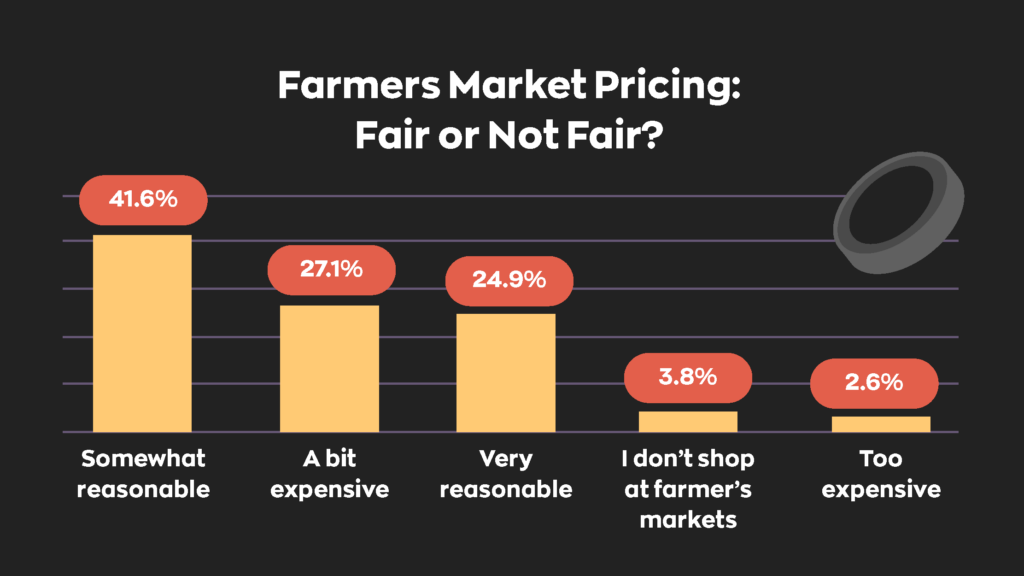
Farmers markets make fresh, locally sourced products accessible to a broader range of consumers, including those with varying budget constraints. This accessibility fosters inclusivity and ensures that high-quality, often organic or specialty items are not limited to higher-income demographics. Moreover, fair pricing practices at farmers markets support local farmers and artisans by offering them a fair return for their labor and produce.
Friendly sellers
The friendly atmosphere created by sellers at farmers markets is a significant draw for shoppers seeking a positive shopping experience. An overwhelming 91% of respondents described their interactions with sellers as friendly. This highlighs the warm and welcoming environment these markets offer.
Our survey data suggests a varied impact of farmers markets on individual perceptions of living or visiting an area. A significant portion, 34.4%, finds their presence moderately influential, while 28.6% feel slightly impacted. Conversely, 27.6% report no influence at all. This underscores the potential role of friendly sellers and community engagement in shaping perceptions of local areas, suggesting that personal interactions and community vibes at these markets may contribute significantly to overall satisfaction.
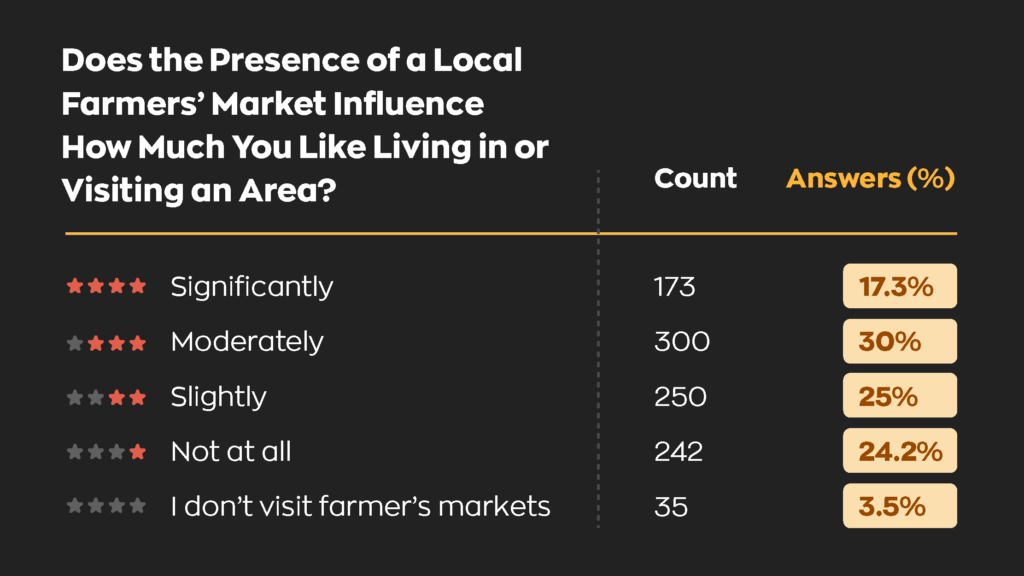
When vendors engage warmly with customers — offering insights on products, sharing recipes, or simply engaging in friendly conversation — it enhances customer satisfaction and fosters loyalty beyond the transactional exchange.
Professionalism among sellers further enhances the appeal of farmers markets. For example, utilizing modern practices such as barcode systems for product identification can help improve efficiency during checkout, reduce wait times, and ensure accurate pricing.
Number of farmers markets by state
The USDA maintains a comprehensive directory of more than 7,000 farmers markets, which includes markets from U.S. territories like Puerto Rico, bringing the number of farmers markets in the continental U.S. to approximately 6,800. To be listed in this directory, a farmers market must meet specific criteria set by the USDA. In 2023, the USDA outlined specific criteria for listing a farmers market in its directory.
To qualify, a market must have at least two or more vendors selling agricultural products directly to customers through a common area or market space. These products include fruits, vegetables, meats, dairy, and other farm-produced items. Additionally, the market must operate in a public or accessible area, such as a street, park, or dedicated market space, ensuring it is easily reachable for the community. The market must also be organized regularly, whether seasonally or year-round and maintain a consistent schedule of operation.
According to Kaggle data based on 2020 research, here's the number of farmers markets in each state of the United States:
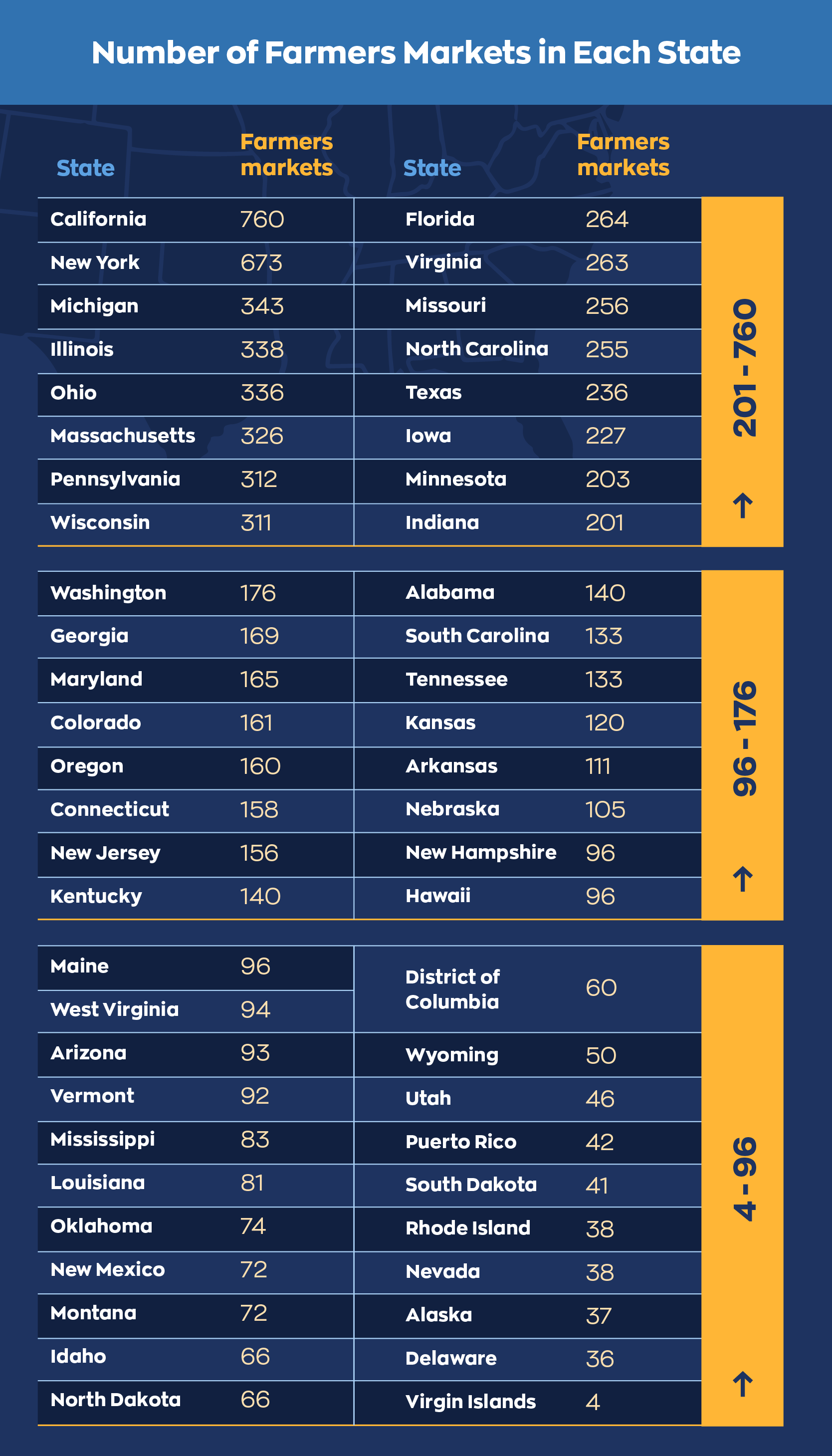
The population numbers referenced in the directory are based on 2020 estimates from the U.S. Census Bureau, ensuring that the data reflects the most current demographic information available.
Furthermore, to meet the USDA's qualifications, the market must prioritize local and regional producers, supporting small-scale farmers and contributing to the local economy. The USDA directory aims to provide consumers with accurate information on market locations, hours of operation, and available products, helping to promote the visibility and accessibility of farmers markets nationwide.
The best farmers markets to visit in each region of the U.S.
Farmers markets across the United States offer unique experiences shaped by regional characteristics, seasonal produce, and local culture. What makes a farmers market stand out can vary widely from region to region. Diverse attributes contribute to the distinctiveness of each market and attract visitors eager to explore local flavors and traditions. This is an exploration of some of the best farmers markets in each region of the U.S. It highlights what makes them exceptional destinations for food enthusiasts and community supporters.
Best farmers markets in the Northeast
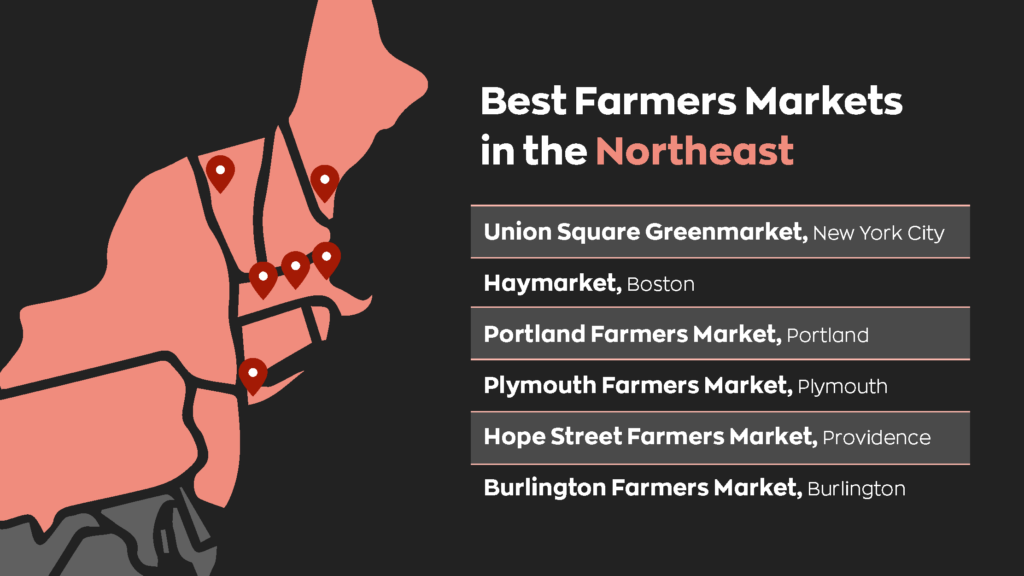
The Northeast region of the United States boasts a rich tapestry of farmers markets, each offering its own unique charm and specialties that reflect the local culture and seasonal bounty. Farmers markets in the Northeast distinguish themselves through their rich history, commitment to community, and emphasis on seasonal and locally sourced products. Here are some standout farmers markets that exemplify the diversity and vibrancy of the Northeast:
Union Square Greenmarket in New York City, New York
Located in the heart of bustling Manhattan's Union Square Park, the Union Square Greenmarket is a celebrated institution dating back to 1976. Open year-round on Mondays, Wednesdays, Fridays, and Saturdays, this market features up to 140 vendors during peak season. Visitors can explore a wide array of offerings, including fresh fruits and vegetables, heritage meats, artisanal cheeses, baked goods, local wines, and much more.
Haymarket in Boston, Massachusetts
Established in 1820, Haymarket is one of America's oldest farmers markets, situated in Boston's historic downtown on Blackstone Street. Operating year-round every Friday and Saturday from dawn until dusk, Haymarket is renowned for its diverse lineup of over 40 independent vendors. Here, shoppers can find an assortment of fresh produce, seafood, flowers, and specialty items, reflecting the multicultural makeup of its vendors.
Portland Farmers Market in Portland, Maine
Dating back to 1768, the Portland Farmers Market in Maine is among the oldest in the nation. It operates at various locations depending on the season, offering fresh produce, artisanal goods, and more. From late April to November, the market is held at Deering Oaks Park, transforming into the Winter Farmers Market at 631 Stevens Avenue from December to mid-April.
Plymouth Farmers Market in Plymouth, Massachusetts
Located at Plymouth Square on Carver Road, the Plymouth Farmers Market provides a picturesque setting less than 10 minutes from the waterfront. Open every Thursday, the market runs outdoors through October and moves indoors from November to May, offering visitors a chance to explore local produce and crafts amid historical exhibits at the nearby Plimoth Plantation on Warren Ave.
Hope Street Farmers Market in Providence, Rhode Island
The Hope Street Farmers Market operates from May through October at Lippitt Memorial Park on the East Side of Providence, managed by local farmers and artisans. Named one of the top farmers markets in America by AAA, it features a wide selection of fruits, vegetables, cheeses, pastries, seafood, and more, emphasizing community engagement and sustainable practices.
Burlington Farmers Market in Burlington, Vermont
Since 1980, the Burlington Farmers Market has been a staple of Vermont's South End community, showcasing over 90 local vendors every Saturday through mid-October. Visitors can shop for seasonal fruits and vegetables, artisanal goods, flowers, and prepared foods while enjoying live music and entertainment. During winter, the market moves indoors to ensure year-round access to local products.
Coventry Farmers Market in Coventry, Connecticut
One of Connecticut's largest farmers markets, Coventry Farmers Market takes place on the grounds of the historic Nathan Hale Homestead, listed on the National Register of Historic Places. Operating every Sunday from June through October, the market features a variety of special events such as chef demonstrations, farm animal visits, and seasonal festivals, making it a family-friendly destination.
Best farmers markets in the Midwest
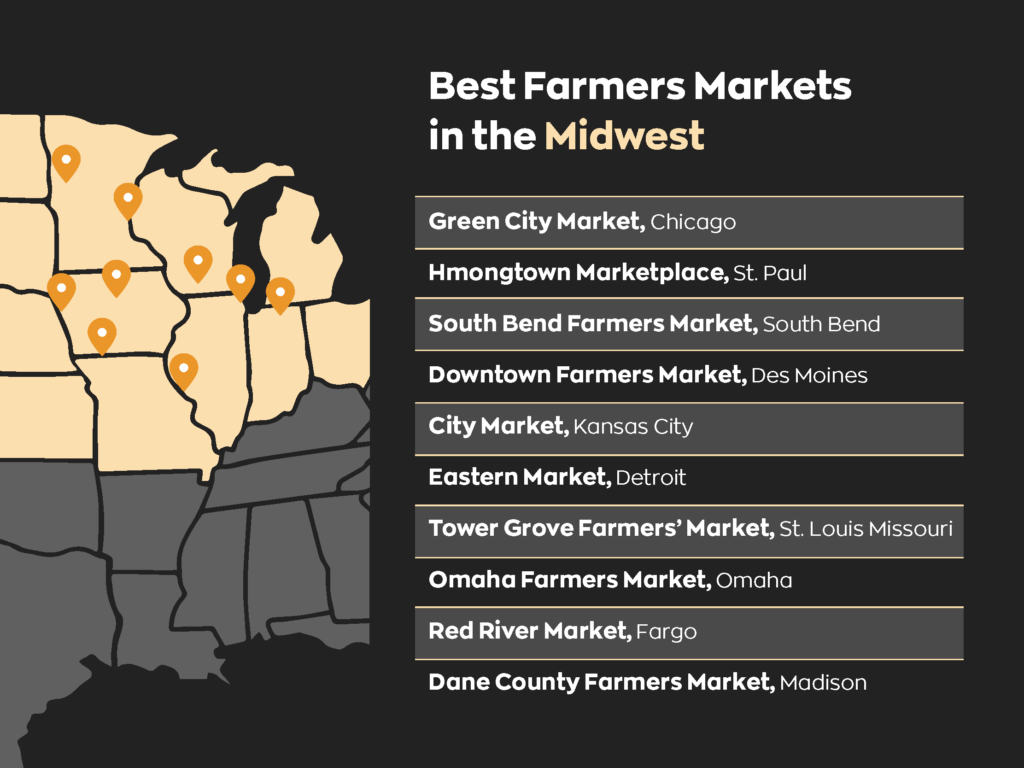
Farmers markets in the Midwest are known for their strong sense of community and focus on local, sustainable, and ethical farming practices. Many markets offer unique cultural experiences, emphasize inclusivity, or reflect the rich agricultural history of long-standing traditions and family-run businesses. Here are some farmers markets that exemplify the Midwest:
Green City Market in Chicago, Illinois
Situated in the Lincoln Park neighborhood, the Green City Market is a key destination for fresh produce, delicious food, and unique items in Chicago. Open year-round on Saturdays and Wednesdays, this market prioritizes ethical and sustainable practices for both animals and the environment. It also strives to improve access to healthy, fresh food by triple-matching purchases made with food assistance programs like SNAP, up to $25.
Hmongtown Marketplace in St. Paul, Minnesota
The Hmongtown Marketplace in St. Paul, Minnesota, provides a unique glimpse into the vibrant Hmong community. Here, visitors can explore a variety of offerings, including apparel, fresh produce, beauty and salon services, and even live chickens. The market also hosts special events, like the My Story Cloth Competition for traditional Hmong quilt-makers. The marketplace operates in two distinct seasons: in May, vendors offer seedlings and starter plants for home gardeners, while from June through October, shoppers can find a wide array of goods and produce.
South Bend Farmers Market in South Bend, Indiana
Since 1911, the South Bend Farmers Market has been a cornerstone of the community. Situated along the St. Joseph River, the market is open year-round on Tuesdays, Thursdays, and Saturdays. Shoppers can discover fresh fruits, vegetables, and handmade products. The Farmers Market Cafe serves dishes made with ingredients sourced from nearby vendors, while Hovenkamp's Produce provides an assortment of wild and specialty mushrooms.
Downtown Farmers Market in Des Moines, Iowa
Covering more than seven city blocks with the historic courthouse as its backdrop, the Downtown Farmers Market in Des Moines is a lively summer tradition. Held on Saturday mornings from May through October, the market draws approximately 25,000 visitors each Saturday. The Spark DSM Minority Business Incubator assists underrepresented and marginalized business owners in establishing a presence in the market. Popular vendors include Grade A Gardens for organic vegetables, Dogpatch Urban Gardens for salad dressings and seasoning salts, and Nadia's French Bakery for buttery croissants.
City Market in Kansas City, Missouri
City Market, situated in Kansas City's River Market neighborhood, exudes an international ambiance with its open-air farmers market encircled by brick-and-mortar food shops and restaurants. Open daily throughout the year, the market showcases a diverse array of vendors offering items such as sweet corn, spring plant starts, falafel, and bulk spices.
Eastern Market in Detroit, Michigan
Established in 1841, Eastern Market in Detroit features 343 vendors spread across several brick buildings. Serving as the cornerstone of one of the largest urban food districts in the country, it offers a wide variety of products, such as oxtail soup, pierogies, mushrooms, and snapdragons. The market is open year-round on Saturdays, with additional markets on Sundays and Tuesdays from June to September.
Tower Grove Farmers' Market in St. Louis Missouri
Founded in 2006, Tower Grove Farmers Market in St. Louis is a relatively new addition to the area. Located in the historic Tower Grove Park, it has quickly become the largest market in the metro region. The market is open on Saturday mornings from spring through fall and on Tuesday evenings from May to September. Visitors can take advantage of free yoga sessions on Saturdays and enjoy picnicking on the grass. Popular vendors include Hafa Adai Catering for Guamanian-style barbecue, Holy Crepe for Nutella and sea salt crepes, and Ozark Forest Mushrooms for specialty mushrooms.
Omaha Farmers Market in Omaha, Nebraska
With origins dating back over a century, the Omaha Farmers Market was revitalized in the 1990s and now operates at two locations: the Old Market district on Saturdays and Stinson Park in Aksarben Village on Sundays. Both markets are open from May to October. Vendors include Erick's Enchiladas, Fermented Felon for craft kombucha, and Daniels Produce for fresh vegetables and canned goods.
Red River Market in Fargo, North Dakota
The Red River Market in Fargo runs from July to October, aligning with the region's shorter growing season. Taking place on Saturdays, this market highlights Fargo's diverse character through a range of vendors. Standout offerings include Adibon, which has African-European fusion cuisine, Flannel Fizz's lavender cream soda, and Lady Gem Jewelry, which has handmade jewelry and curated gemstones.
Dane County Farmers Market in Madison, Wisconsin
Established in 1972, the Dane County Farmers Market in Madison takes its cue from European open-air markets. Operating on Wednesdays and Saturdays from spring through late fall, the market boasts hundreds of vendors offering hyper-local goods. Visitors can indulge in a diverse array of cheeses from Hook's Cheese Company and Bleu Mont Dairy, as well as Stella's renowned spicy cheese bread.
Best farmers markets in the South
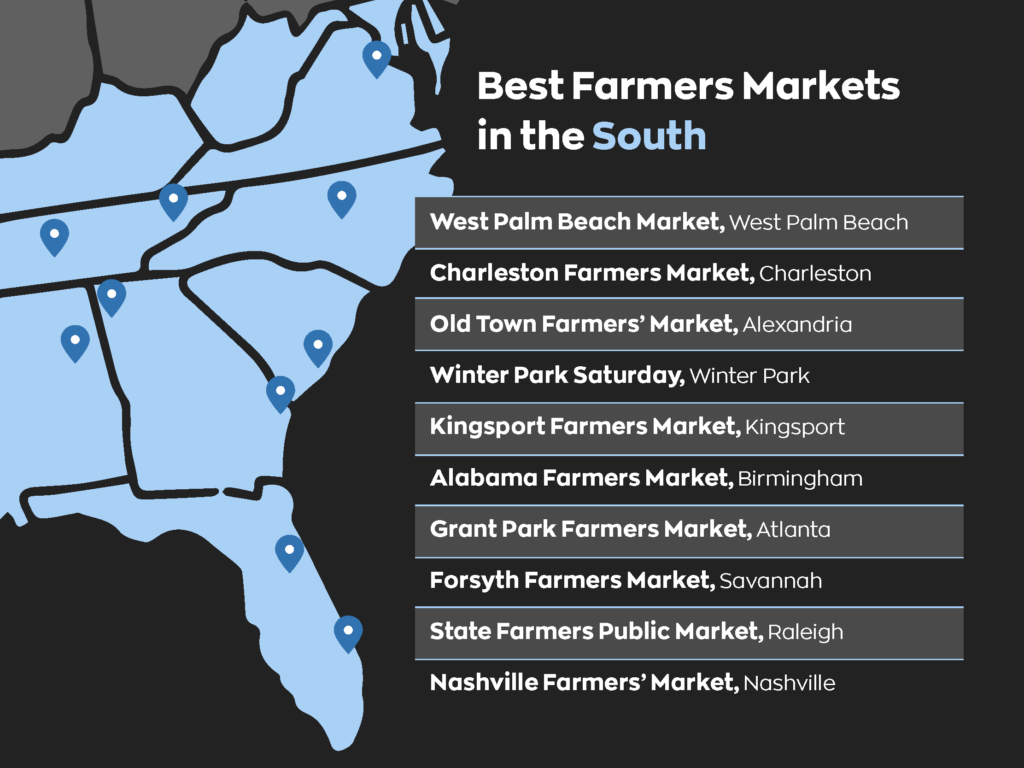
Farmers markets in the South are celebrated for their unique characteristics, vibrant communities, and diverse offerings. They reflect the rich cultural heritage and agricultural bounty of the region. Here are some of the standout farmers markets in the South. Each one with its own special characteristics that make them distinct:
West Palm Beach Green Market in West Palm Beach, Florida
The West Palm Beach Green Market in Florida has consistently been recognized as one of the nation's top green markets for years. This seasonal market, which runs from October to April, is situated on the West Palm Beach waterfront and hosts over 100 vendors. These vendors offer a variety of products, including artisan breads, local honey, gourmet pickles, spicy sauces, orchids, and more. The market is renowned for its vibrant social atmosphere, featuring freshly baked cider doughnuts and healthy choices like açaí bowls and smoothies.
Charleston Farmers Market in Charleston, South Carolina
Established in 1989, the Charleston Farmers Market in South Carolina is situated in Marion Square, at the center of the Historic District. Open from April to November, this market features Lowcountry vendors offering food, crafts, flowers, and live entertainment. It's known for its charming Southern hospitality and pet-friendly atmosphere, making it a highlight for visitors and locals alike.
Old Town Farmers' Market in Alexandria, Virginia
The Old Town Farmers' Market in Alexandria, Virginia, holds the distinction of being America's longest continuously operated farmers market at the same location since 1753. This market operates every Saturday throughout the year, regardless of weather conditions, and features over 70 vendors at its peak. It offers a variety of baked goods, meats, flowers, local produce, and more, enhanced by its historical setting for a distinctive shopping experience.
Winter Park Saturday Farmers' Market in Winter Park, Florida
The Winter Park Saturday Farmers' Market in Florida is a gem of Central Florida, open year-round every Saturday morning. This market is known for its variety of fresh offerings, including baked goods, unique jerkies, food trucks, and butterfly gardens. It also provides additional services like knife sharpening for locals.
Kingsport Farmers Market in Kingsport, Tennessee
Established in 1977, the Kingsport Farmers Market operates from April to November and features unique programs like "Evening at the Market" with bluegrass concerts, free gardening classes, and chef demonstrations. This market is community-centric, offering educational and entertaining events in addition to regular market offerings.
Alabama Farmers Market in Birmingham, Alabama
Birmingham's Alabama Farmers Market is a massive market open 365 days a year, from sunup to sundown. Located on a 49-acre site, it offers a comprehensive shopping experience with a flea market, local produce, truck vendors, and a restaurant. Its historic roots date back to 1921, adding to its charm.
Grant Park Farmers Market in Atlanta, Georgia
Located in a beautiful parkside setting in Atlanta, Georgia, the Grant Park Farmers Market is open every Sunday year-round, except on major holidays. The market features bread, vegetables, organic fruits, meats, artisanal foods, and weekly demos by celebrity chefs.
Forsyth Farmers Market in Savannah, Georgia
The Forsyth Farmers Market in Savannah, Georgia, is held in the picturesque Forsyth Park every Saturday morning. Visitors can meet local artisans and sample goods at this market, which offers a wide selection of farm products and prepared foods in a beautiful setting. It's the perfect start to a Saturday morning in Savannah.
State Farmers Public Market in Raleigh, North Carolina
Located in Raleigh, North Carolina, the State Farmers Market spans 30,000 square feet and offers fresh produce and specialty farm products year-round. This expansive market includes a drive-through Truckers Building, an indoor Market Shoppes area, a wholesale terminal, and restaurants. Its two-acre Market Imports area, showcasing items from around the world, makes it a must-see destination.
Nashville Farmers' Market in Nashville, Tennessee
The Nashville Farmers' Market in Tennessee offers produce, local artisanal foods, crafts, shops, restaurants, and classes. Open year-round, it provides a break from the hustle and bustle of Nashville's Broadway with educational chef demos and classes.
Best farmers markets in the West
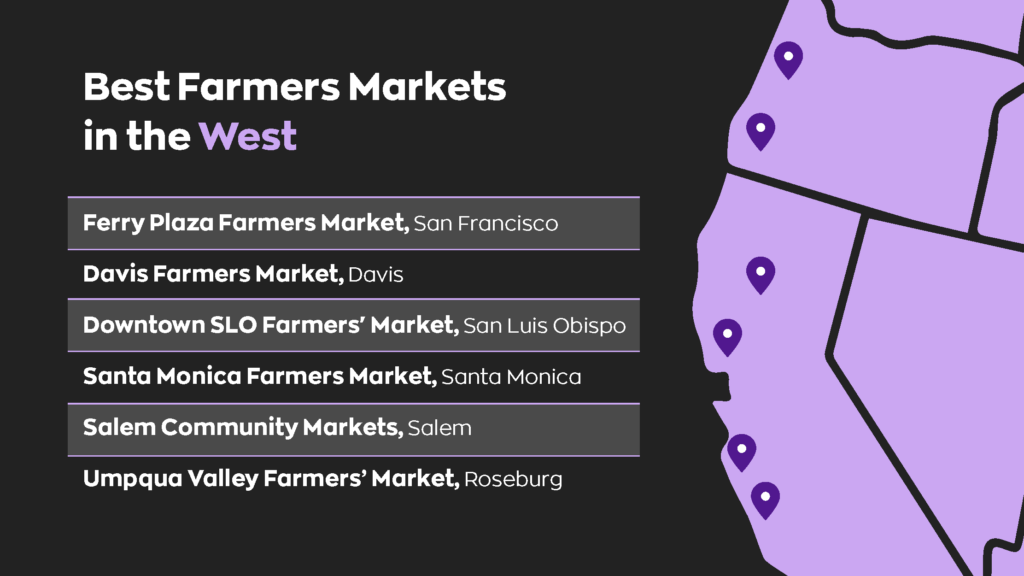
Farmers markets in the West are renowned for their vibrant atmospheres, diverse offerings, and scenic locations. Many are located in picturesque settings, such as waterfronts or historic districts, providing a beautiful backdrop for shopping. These markets often host events, live music, and educational programs, creating a vibrant community atmosphere.
The variety of products available, from fresh produce to artisanal goods, reflects the innovative spirit of the region. Here are some of the most popular farmers markets in the region, each with unique characteristics that make them stand out:
Ferry Plaza Farmers Market in San Francisco, California
Located in San Francisco, the Ferry Plaza Farmers Market offers scenic views, savvy shoppers, and incredible local produce. This market is open three days a week (Saturday 8am-2pm, Tuesday 10am-2pm, and Thursday 10am-2pm), year-round, rain or shine, and takes place outdoors at the Ferry Plaza. It is a must-see destination for its stunning waterfront location and wide variety of fresh fruits and vegetables.
Davis Farmers Market in Davis, California
Situated in Davis, California, this market is held on Wednesday afternoons and Saturday mornings. Close to the heart of California's produce region, it hosts fun events during peak times of the year, making it a lively and friendly place to shop. The market features a variety of booths selling more than just food, adding to its charm.
Downtown SLO Farmers' Market in San Luis Obispo, California
The San Luis Obispo Farmers' Market is held every Thursday, except on federal holidays. Known for its delicious local produce and meal options, this market offers pulled pork and live music, making it a vibrant community event. It's an excellent place to enjoy local flavors and entertainment.
Santa Monica Farmers Market in Santa Monica, California
Held every Wednesday, Saturday, and Sunday, the Santa Monica Farmers Market is a popular destination for fresh produce, vendors, and even celebrity sightings. Located near the beach, it offers a unique shopping experience combining fresh food and the scenic beauty of Santa Monica.
Salem Community Markets in Salem, Oregon
While not as large as some of the other markets, Salem Community Markets is a staple in the town. It takes place every Saturday starting in April, offering local food and artisan goods. It's a great way to enjoy the town's charm while snacking on fresh produce.
Umpqua Valley Farmers' Market in Roseburg, Oregon
Located in the Umpqua Valley, this market supplies some of Oregon's best produce every Saturday. It features meat, eggs, fresh produce, local honey, and artisans. The market provides a delightful shopping experience with healthy produce and unique local treats.
Methodology
To identify the best farmers markets in the South and West regions of the United States, we utilized data from the United States Department of Agriculture (USDA) and datasets from Kaggle to determine the number of farmers markets in each state. Our analysis focused on markets in states traditionally considered part of these regions.
Selection criteria included market popularity, historical significance, variety and quality of offerings, community engagement, and customer reviews. We also gathered information from websites, journals, and articles from reputable publications, as well as statistics from authoritative sources like Statista and the Farmers Market Coalition. Findings were aggregated based on vendor diversity, community activities, historical significance, visitor experience, and accessibility to determine the top markets in the United States.
Fair use policy
You are welcome to utilize the insights from this study for noncommercial purposes. Feel free to share the information about the best farmers markets within your community. If you reference or share this study, we kindly ask that you include a link back to this page. This link will provide your audience with access to our comprehensive findings, methodology, and full context of this analysis.


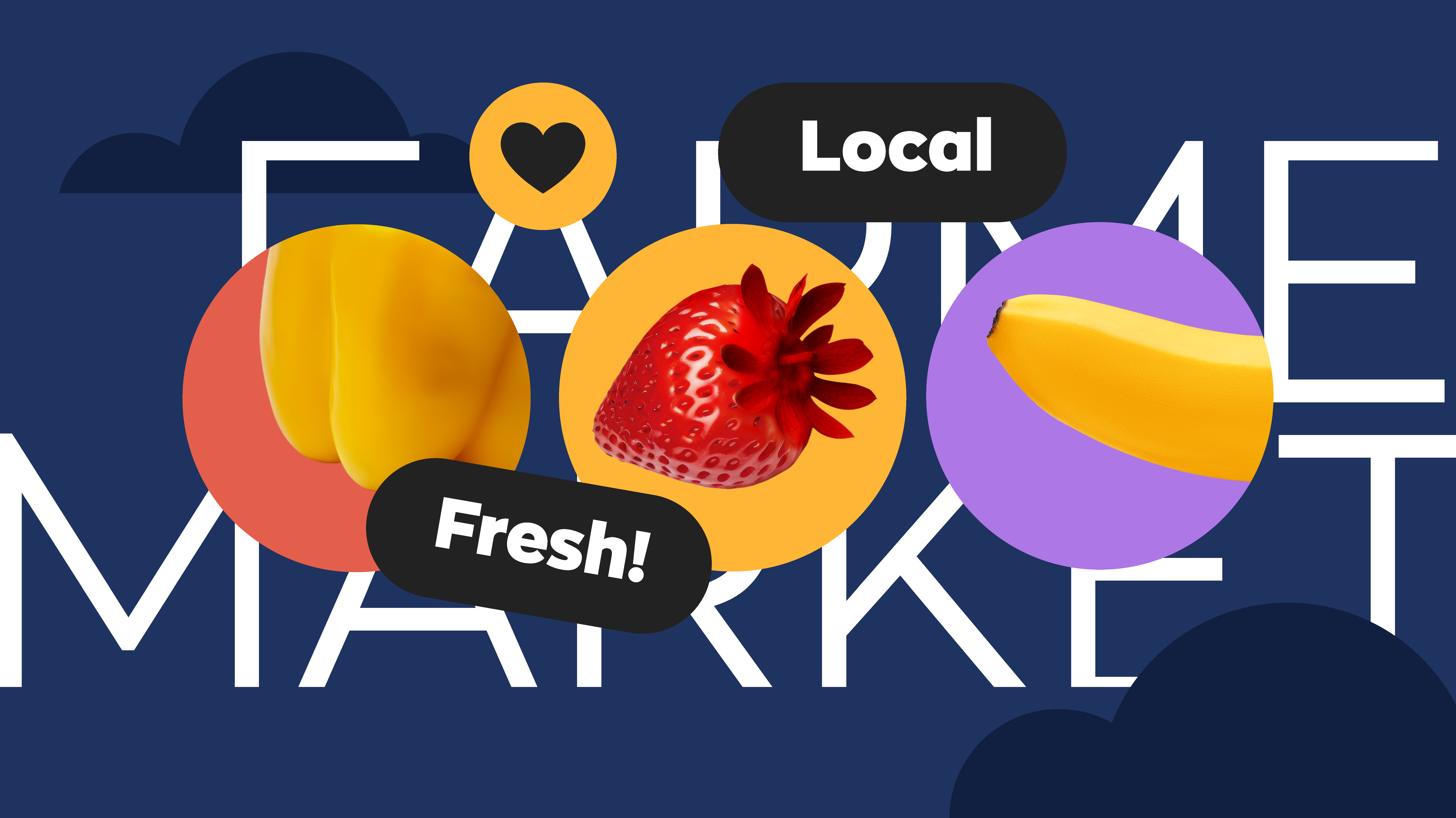



0 Comments